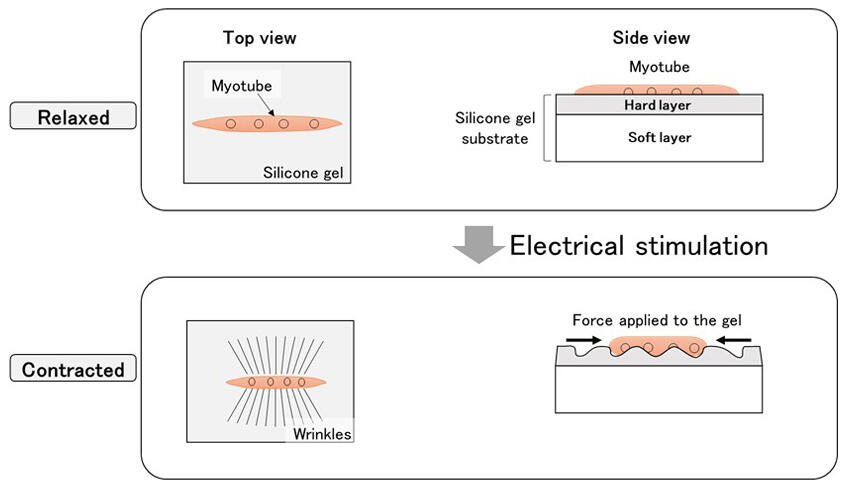A research group led by graduate student Hiroki Hamaguchi, Associate Professor Yasuko Manabe, Assistant Professor Yasuro Furuichi, and Professor Nobuharu Fujii of the Graduate School of Health Sciences, Tokyo Metropolitan University, and Professor Shinji Deguchi and lecturer (at the time) Tsubasa Matsui of the Graduate School of Engineering Science, Osaka University, has developed a system to effectively evaluate contractile force (muscle strength) from the length of wrinkles on a specially processed silicone gel with seeded myotube cells when they are contracted by electrical stimulation. This has enabled the effective verification of the actions of compounds and food ingredients that prevent muscle weakness and promote muscle growth, using the contractile force of myotube cells as an index.

Provided by Tokyo Metropolitan University
To create a new system for evaluating the contractile force of cultured myotube cells, the research group focused on a gel with two layers, a soft layer and a hard layer. The gel forms fine wrinkles on the surface when force is applied. Primary cultured skeletal muscle cells derived from mice were differentiated into myotube cells and seeded on the gel. By adjusting the stiffness of the gel, the researchers found conditions under which wrinkles form on the gel surface only when myotube cells contract upon electrical stimulation. The length of the wrinkles on the gel surface correlated with the amount of force applied to the gel.
They were able to evaluate the contractile force by analyzing the length of the wrinkles caused by the contraction of myotube cells. They extracted only wrinkle information from video of cell contraction and relaxation, and the total length of wrinkles produced by three contractions was defined as the "Force Index."
Furthermore, they tested the method they developed on model cells to see if they could evaluate muscle cell atrophy and hypertrophy. The Force Index significantly decreased in the atrophic muscle model cells, which reproduced muscle weakness, and significantly increased in the hypertrophic muscle model cells, which reproduced muscle gain. The method was more sensitive to detecting changes in muscle function than myotube cell thickness or myosin heavy chain expression, which have been used as alternative assessment methods of contractile force.
"In the future, we would like to apply this system we developed to the search for new drug candidates that can effectively prevent or treat muscle weakness," explains Dr. Manabe. "We also plan to expand our research into understanding the causes of muscle atrophy by analyzing the mechanisms by which drugs work."
Journal Information
Publication: Scientific Reports
Title: Establishment of a system evaluating the contractile force of electrically stimulated myotubes from wrinkles formed on elastic substrate
DOI: 10.1038/s41598-022-17548-7
This article has been translated by JST with permission from The Science News Ltd.(https://sci-news.co.jp/). Unauthorized reproduction of the article and photographs is prohibited.




